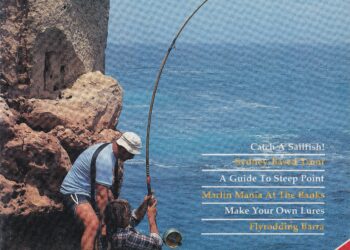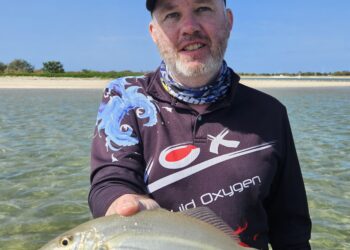
WITH the summer holidays looming, now’s the time to start planning a fishy escape. BEN CADDAYE outlines the angling options along southern NSW’s Eurobodalla coast.
IT’S a stretch of NSW coastline synonymous with exquisite waterways and first-rate fishing. It’s also one of the hottest summer holiday destinations for anglers from Canberra, Sydney and beyond. The Eurobodalla coast, which extends from just north of Batemans Bay to just south of Narooma, is a haven for anglers, boasting scores of saltwater creeks, rivers and lakes.
In fact, Eurobodalla means “Land of Many Waters” in the local Aboriginal dialect, so if you’re into estuary fishing, you couldn’t find a better place to wet a line. The Eurobodalla coast has been my saltwater stomping ground for more than 30 years and I’ve fished most of the estuaries in this special part of the world. Some have been very kind to me over the years; other have been more challenging. I’ve enjoyed every second I’ve spent exploring them on a boat, kayak or on foot. With thousands of holidaying anglers destined to visit the Eurobodalla region over the coming summer holidays, here’s a guide to fishing some of my favourite rivers and lakes in this pristine pocket of south-eastern Australia.
Durras Lake
Durras Lake sits at the northernmost point of the Eurobodalla region. Located a few clicks north of Batemans Bay, Durras is a small, shallow estuary – but it punches well above its weight in the fishing stakes. The anglers who get the most out of Durras are those prepared to jump in a canoe or kayak and explore its expansive shallows. Flathead and whiting are the staples over the flats during summer. It’s become one of the gun locations on the coast for surface-lure enthusiasts, with poppers, walkers and stickbaits undoing plenty of flatties and whiting when the water warms during December and January.

The lake does feature a few holes and drop-offs and these are ideal for exploring with soft plastic lures for large flathead. Just because Durras is small, doesn’t mean its flathead don’t grow big. Every season a handful of fish around the 90cm mark are taken from the lake. Bait is great at Durras, too. Working the shallows with fresh nippers and worms will yield a steady stream of whiting, flathead and bream.
Clyde River
The Clyde River is by far the largest estuary system in the Eurobodalla and it’s a focus for literally thousands of anglers over summer. The Clyde is huge. It begins in the hills as a tiny crystal clear freshwater stream before winding its way some one hundred kilometres and spilling into the sea at Batemans Bay. Deep water – up to 20m in parts – and strong tidal flow can make the Clyde difficult to fish at times, but if you get it right it has the potential to dish up the finest fishing you’re likely to find on the Far South Coast.
This summer, most visiting fishos will try their luck between the two highway bridges – at Nelligen and Batemans Bay. Flathead, bream and tailor are abundant and can be caught from a drifting boat or kayak on soft plastic lures and fresh and live bait. Don’t focus too much on fishing the deepest holes for these species; they’ll most likely be found where the deeper water gives way to the shallows, especially around weed-beds and rock bars. The Clyde is also renowned for its monster mulloway. These are taken by experienced anglers fishing the deep holes and “bait balls” with big soft plastic lures, live baits and fresh dead baits.
The Clyde’s upper reaches, around Shallow Crossing, are brilliant areas to target bass and EPs. It’s stunning country up here. Drifting in a kayak and pelting hard-bodied lures at the rock bars and sunken timber is a sublime way to pass the time. Expect to hook into some beaut fish, too.
Moruya River
The Moruya River doesn’t tend to get the plaudits that some of the better-known estuaries to the north and south receive, but it can certainly compete as a fishery with the more “glamorous” waterways of the Eurobodalla. The lower reaches of the system are fertile drifting grounds for bream and flathead.

The stretch of river between the mouth and the highway bridge is littered with rock walls, weed-beds, sand flats and creeks. Focusing on these forms of natural and man-made structure can result in terrific catches of flatties, mainly on Squidgy Wrigglers and similar plastics. Hard-bodied divers and surface lures fished over the seagrass beds will coax good numbers of bream and whiting. Another productive patch to fish is the stretch of river upstream of the highway bridge, where flathead and bream abound over the sand and around the rocks. The upper reaches of the river produce estuary perch and bass.
Unlike some South Coast estuaries, the Moruya River has lots of great shore-based options. Near the river mouth, there are breakwalls on both the northern and southern sides that provide a relatively safe and accessible place to chase tailor, salmon, bream and flathead. The wharf near the historic quarry has recently been upgraded and is a great fishing platform for bream, flathead and tailor. So is Preddys Wharf near Moruya Heads.
Tuross Lake
Lake Tuross is the poster child for “rec-only” fisheries on the NSW South Coast. Since commercial fishing was banned well over a decade ago, Tuross has quickly gained a reputation as one of the fishiest estuaries in the state, with anglers often prepared to travel long distances to fish its waters. A number of well-known anglers from television and magazines fish Tuross regularly. In fact, a day spent on the lake over the holidays can be a bit of an exercise in spotting the fishing “celebrity”.
With commercial netting now a distant memory, species such as flathead, bream, whiting, EPs and mulloway have thrived in Tuross. Flathead are the main drawcard. Tuross produces a handful of huge flatties every year – and you don’t have to go far for these fish, either. Many are caught within sight of the various waterfront cafes and eateries that swell with tourists over the Christmas break.
Live poddy mullet are deadly on big Tuross crocs, but you can also try large soft plastics bounced around the drop-offs. Anglers employing this technique are also in with the chance of a prized mulloway. Big whiting are on offer towards the mouth of Tuross on fresh bait, vibe lures and surface poppers. The oyster racks that abound throughout the system are magnets for bream, and fishing small soft plastic and minnow-style lures around the leases on a boat or kayak can often result in an action-packed session.
The picturesque upper reaches of Tuross are brilliant for bass. Access via boat to this water can be problematic above the highway bridge, with shallow stretches preventing all but the smallest craft from getting through. It’s perfect for kayaks and canoes, though.

Wagonga Inlet
Wagonga has been a rec-only fishery longer than any other estuary on the South Coast – and it shows. Its reputation a first-rate location for monster flathead, big bream, fat whiting and mulloway is legendary. Like Tuross, Wagonga’s crocs grab most of the headlines. They live around the drop-offs, where the sandflats drop away to holes and channels more than 10m deep.
Large soft plastic lures, especially big shads, on relatively heavy jig heads are the go-to artificials for true trophy lizards. Experienced anglers tend to follow around the schools of bait and feeding tailor, and deliberately fish under the surface action. Mulloway are also on the cards in Wagonga and are often caught by anglers fishing for flatties.
The sandflats and channels towards the front of the system, between the lake and the entrance, are home to big whiting. Target these fish with fresh nippers. The oyster racks up the back of the inlet are a noted haunt for big bream. Shore-based anglers can stroll along the “Boardwalk”, which boasts purpose built fishing platforms. Expect to catch bream, flathead and leatherjacket in this area. Note the marine park sanctuary zones within the system.




















